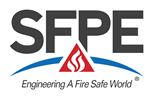FEMTC 2020
Role Of The Cost Function For Material Parameter Determination 
Patrick Lauer - University of Wuppertal, Germany
Abstract
Inverse modelling of bench-scale experiments is a common method to determine material parameters for pyrolysis simulation, e.g. to compute flame spread. A key component is the cost function as part of the minimisation process. This scalar function describes primarily the deviation between the experimental data, i.e. target data, and the simulation model’s response to a parameter set. This function drives the whole system and determines its stiffness, which in this context indicates the amount of parameter sets which lead to zero or near-zero deviations.
This contribution evaluates various approaches to compute the distance between two data sets, here experimental vs. simulation data. In cases, where only a single experiment is considered, the comparison can be directly achieved with common measures, like RMSE. However, if multiple data sets, e.g. micro- and bench-scale, are used, the question of a weighting arises. Methods to normalise data sets are outlined to achieve an adequate weighting and a general approach is proposed. This will be illustrated by considering multiple physical quantities, like surface temperature and mass loss rate, for different experimental set-ups, here cone calorimeter and TGA.
Another aspect of the cost function is the induced stiffness. A strict comparison of experimental and simulation data will never reach zero values, i.e. perfect fitting. To face this aspect, a cost function that uses a data band is introduced. Assuming uncertainties in the experimental and simulation data, this is not limiting the quality of the inverse modelling. Yet, this less stiff system leads to benefits like quicker convergence and robust solutions. A further advancement to the cost function is the targeting of individual features, like ignition time or heat release peaks. As these may be of crucial importance for the real-scale applications, especially for flame spread modelling, a methodology to capture and to weight those features is outlined.
The presented approaches are demonstrated for selected data sets from the MaCFP Working Group and own experiments. The inverse modelling is conducted with PROPTI and FDS as the simulation software. Data and models used for this contribution are all freely available.
Presentation
Resources
| Paper | Presentation | ||
|---|---|---|---|
| HTML | HTML | ||
| Resources Archive File (.zip) | |||

